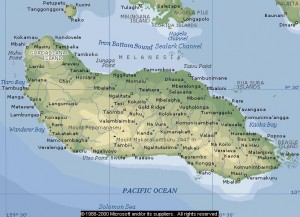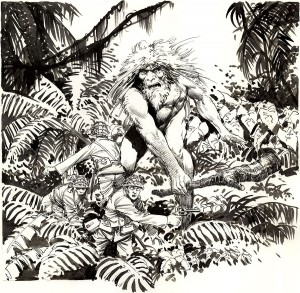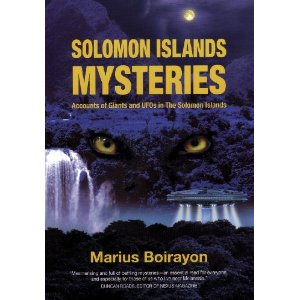Solomon Islands’ Giants
Posted by: Loren Coleman on October 28th, 2010
Are you ready for dramatic news in the next year of an expedition exploring a new corner of the world?
During the 21st century, a surprising new source of True Giants research has blossomed in an overlooked location, the Solomon Islands. Researchers have discovered a treasure trove of traditions and tales from the indigenous peoples there. They are to be congratulated for working away, mostly in the shadows, on a topic few wish to hear about.

The Solomon Islands is a sovereign state in Oceania, east of Papua New Guinea, consisting of nearly one thousand islands. In size, it covers area slightly smaller than the state of Maryland.
The Solomon Islands are believed to have been inhabited by Melanesian people for thousands of years. Spanish navigator Alvaro de Mendaña discovered the islands in 1568 and named them Islas Salomon. The United Kingdom established a protectorate over the Solomon Islands in 1893. In the Second World War, there was fierce fighting between the Americans and the Japanese in the Solomon Islands campaign of 1942–45, including the Battle of Guadalcanal. Most Americans are familiar with the area through the name Guadalcanal.
It is believed that Papuan-speaking settlers began to arrive around 30,000 BC. Austronesian speakers arrived circa 4,000 BC also bringing cultural elements such as the outrigger canoe. It is between 1,200 and 800 BC that the ancestors of the Polynesians, the Lapita people, arrived from the Bismarck Archipelago with their characteristic ceramics. The first European to visit the islands was the Spanish navigator Álvaro de Mendaña de Neira, coming from Peru in 1568. The people of Solomon Islands were infamous for headhunting and cannibalism before the arrival of the Europeans. How diverse is the Solomon Islands? One hundred and twenty indigenous languages are spoken in the Solomons.

The capital, Honiara, is located on the island of Guadalcanal. Americans recognize the name Guadalcanal, because of the fierce fighting that took place their during WWII between the Japanese and Americans. But that was not the only conflicts occurring.

Japanese soldiers encounter a True Giant in the Solomon Islands. (Drawing by and permission given for its use by Brian Snoddy. Visit his art page here.)
Are there True Giants on the Solomons? It would appear that from the people there who are newly communicating what they have known for years, yes, there may be.
Marius Boirayon, Research Director, Solomon Anthropological Expedition Trust Board Incorporated, is one of the researchers who has been doing investigations in The Solomon Islands on the accounts of True Giants. Australian Boirayon who lived and worked in the Solomons as a helicopter pilot and engineer, ended up marrying a Solomon Islander. He grew to know and appreciate the culture, the folklore, and the day-to-day interaction between the natural history of the area and the people living there. Before long, he began hearing about the stories of the giants and decided to write of what he was learning.

In his book, Solomon Island Mysteries (Adventures Unlimited Press, 2010), Boirayon first chronicles the information he was gathering from the natives, of whom his wife is one, from the Solomons. He came to know that there were giants on islands, one that was large, over 10 foot tall, with evidence that supports that the giants do grow much taller than that. These Guadalcanal Giants, as he calls them, have very long black, brown or reddish hair, protruding double eyebrows, bludging red eyeballs, flat noses, and wide gapped mouth facial features. Awareness of them is shown by the newspapers, as well.

Harry Trumbore’s illustration (above) is of one of the Malaysian True Giants, locally called Orang Dalam (from The Field Guide of Bigfoot and Other Mystery Primates, 2006). They are said to be upwards of 20 feet tall, and similar to the ones seen in the Solomon Islands.
“The Solomon Islanders…are lacking the understanding that their Giant race [would be a] big scientific discovery to the rest of the World. Whether by design or not, it is appropriate that the Solomon Island’s National logo is ‘The Place That Time Forgot,'” Boirayon points out.
Boirayan has collected firsthand accounts of the sightings of the Giants, said to be over 15 feet tall and which leave footprints around construction sites. There are even kidnapping stories. He shared on one website the following: “The Guadalcanal people, and many others, all know the story of ‘Mango,’ whom passed away two years ago. She had been kidnapped by the Giants fifty years ago and spent 25 odd years with them, and like them all they had given her up for dead until she was found pregnant, hysterically frothing from the mouth in a garden on the Northeast coast. A Giant had taken her as a wife. When the men realized who she was, they tried capturing her, but because her skin was as slimy as an eel, they found it difficult holding her. One of the men got an ingenious idea and got some particular rough-sided leaves of which they used to hold her down and tie up with vine. Understandably, she was mentality unstable for the remainder of her life, but through her pregnancy she gave birth to a half-cast boy. The bastard boy lived to the age of five when one of Mango’s brothers slaughtered him. Peter and a few other friends of mine know where he is buried. Mango is just one of many that this type of thing has happened too, but you don’t have to believe me, just ask them. There are quite a few more.”
Is Melanesia a fertile new area for groundbreaking research on True Giants? Of course it is. It took a man who married into the culture there to crack a layer of silence that often exists for outsiders. As my forthcoming book with Mark A. Hall, entitled True Giants: Is Gigantopithecus Still Alive? goes to press, we are being told that an exploratory effort of a cryptozoological nature is being planned to the Solomon Islands in 2011, to do more research on the True Giants, and try their best to film those unknown hominoids.
I wish the Solomon Islands Giants Expedition and its members well. BTW, if someone wants to send me a ticket, I’ll be there in a flash investigating those True Giants!

About Loren Coleman
Loren Coleman is one of the world’s leading cryptozoologists, some say “the” leading living cryptozoologist. Certainly, he is acknowledged as the current living American researcher and writer who has most popularized cryptozoology in the late 20th and early 21st centuries.
Starting his fieldwork and investigations in 1960, after traveling and trekking extensively in pursuit of cryptozoological mysteries, Coleman began writing to share his experiences in 1969. An honorary member of Ivan T. Sanderson’s Society for the Investigation of the Unexplained in the 1970s, Coleman has been bestowed with similar honorary memberships of the North Idaho College Cryptozoology Club in 1983, and in subsequent years, that of the British Columbia Scientific Cryptozoology Club, CryptoSafari International, and other international organizations. He was also a Life Member and Benefactor of the International Society of Cryptozoology (now-defunct).
Loren Coleman’s daily blog, as a member of the Cryptomundo Team, served as an ongoing avenue of communication for the ever-growing body of cryptozoo news from 2005 through 2013. He returned as an infrequent contributor beginning Halloween week of 2015.
Coleman is the founder in 2003, and current director of the International Cryptozoology Museum in Portland, Maine.










I am enthralled by the idea of hairy giants roaming the dense jungles of the solomon islands, and hope that if a few brave souls manage to muster an expedition to these wild outcroppings that they don’t go falling into any “subterranean UFO Bases.”
As someone with an interest in islands, insular evolution, and island ecosystems, I am always fascinated to hear of accounts and new areas of inquiry such as these Solomon Island giants.
The report made by Japanese soldiers is interesting, and I may add no particularly unusual. It is interesting when one looks into the old accounts, just how many reports of strange creatures popped up during World War II in various far flung Pacific Islands. Many of these islands were remote and long isolated from the presence of outsiders, yet exhibiting a great many strange, ethnoknown creatures. Japanese soldiers produced a great many accounts of bizarre animals in these places such as these giants, many of which were hardly ever mentioned again after the war ended. I often wonder why it is that these reports, perhaps the first time outsiders had ever been exposed to these potentially new creatures, so often faded away.
I know of a great many stories concerning bizarre creatures purportedly encountered by Japanese soldiers, and it seems like an area ripe for digging deeper into. I commend the author of this book for making an effort to glean more information from these obscure reports.
The giants themselves also make for a great discussion on the biology involved. What are they? How would they fit into the ecosystem? In what ways were their physiologies able to adapt to overcome the challenges that come with such a large size? While possible for quadrupeds, with the structure of a true biped, how is it that they have evolved to be able to stand 20 feet tall?
There are some possible answers I can think of. Perhaps these are the descendants of early hominids that displayed island gigantism, similarly to how conversely Homo floresiensis is thought to be hominds who went the other route and miniturized due to insular dwarfism. Yet, 20 feet tall? It is interesting to ponder such a size, how the creature could have gotten to that point, how it would have adapted, and what it’s place in the natural world would be.
So many questions. Perhaps Boirayon can help to uncover some answers.
20 feet tall humans? That is something there. I think a 20 foot tall human would be more of a discovery then a live dinosaur. XD
Interseting when us crypto fans find out new things our mind just expands even more. I hope they still exist. 🙂 I would love to see a living giant bigger then the biggest human recorded alive in modern times.
@mystery_man:
I have been interested in Solomon Islands mysteries (of which there are four, not necessarily connected with each other, namely giants, “small people”, strange lights in the sky and mysterious ancient (?) ruins) for at least the last four or five years.
In 2008 I managed to go to Solomon Islands to try and check the veracity of Mr Marius Boirayon’s claims that he put in his articles and his book. Obviously four weeks (that was all the time I had at the moment) was far too short to be able to do it properly, but I have made an observation of lights in the sky (while obviously very far from claiming – without further clarification – that these ware alien craft, they were nevertheless unidentified and therefore UFOs), and – judging from some mails on some little-known Guadalcanal and Malaita social forums – they may have been some secret military technology.
Since my return, I have been itching to go to Solomon Islands, this time for a much longer time, to research all four mysteries in more detail. Obviously, money is the major obstacle, but I am determined and hoping to go in the second half of 2011.
What you are saying is amazingly interesting!
Cryptomundo Policy Note: Some people have written asking for contact info so they may go on this expedition. Comments are not for personal contact use and should not be used in the place of person-to-person forms of communiques. Cryptomundo is not responsible for any form of personal liability resulting from contact attempted beyond our comment forum, and we advise against using our comment section for personal messages. As part of the standard policy of Cryptomundo, personal contact information and email addresses are not shared.